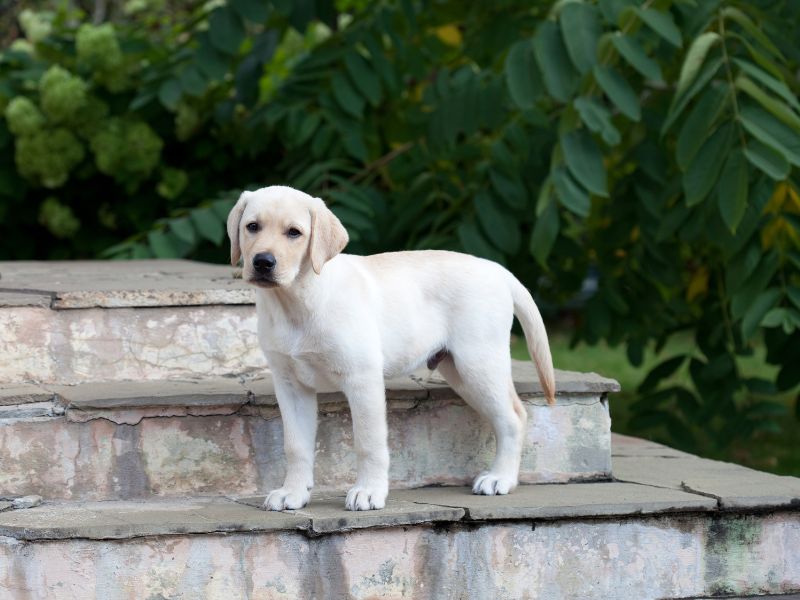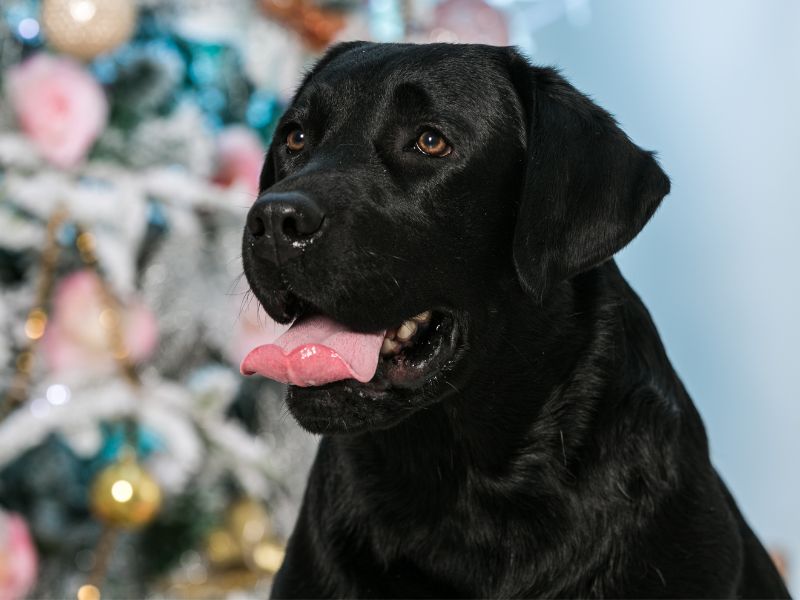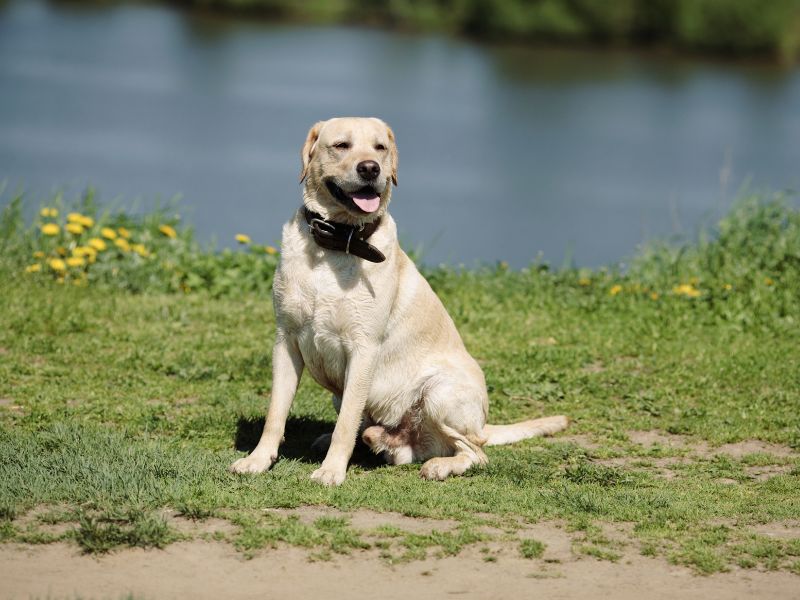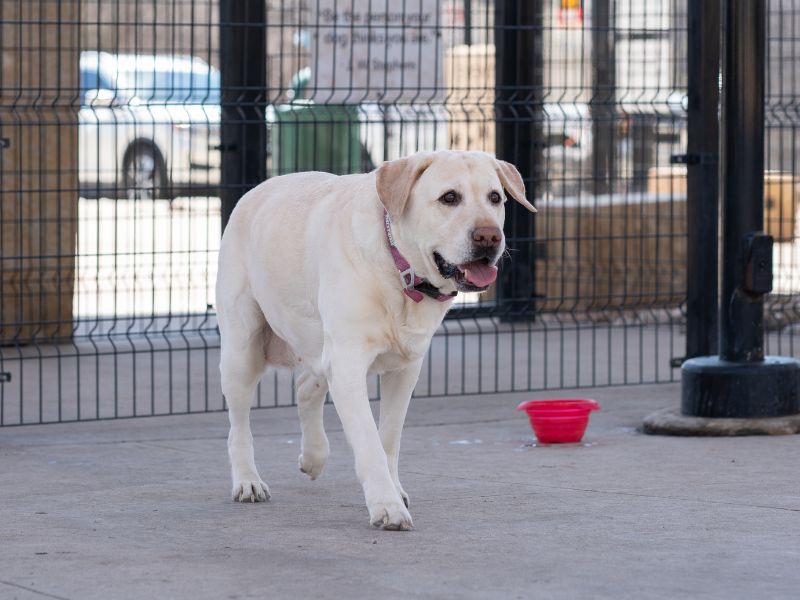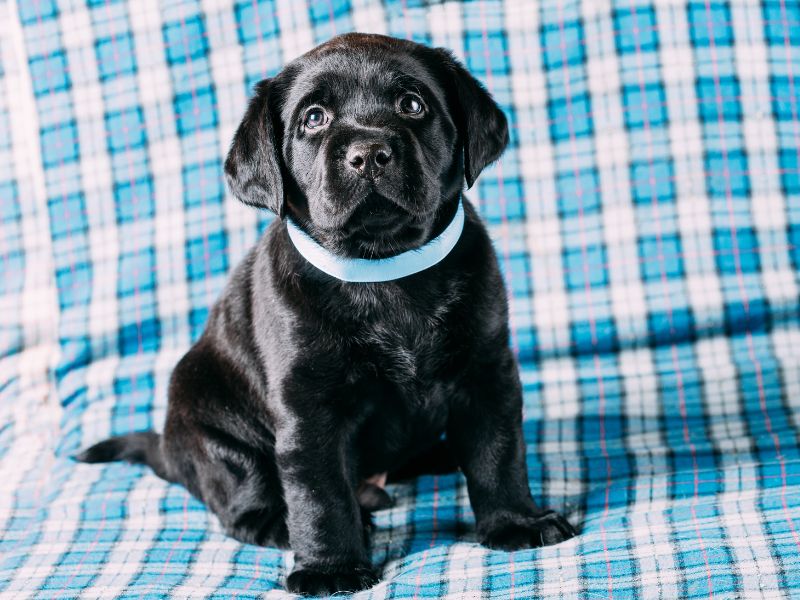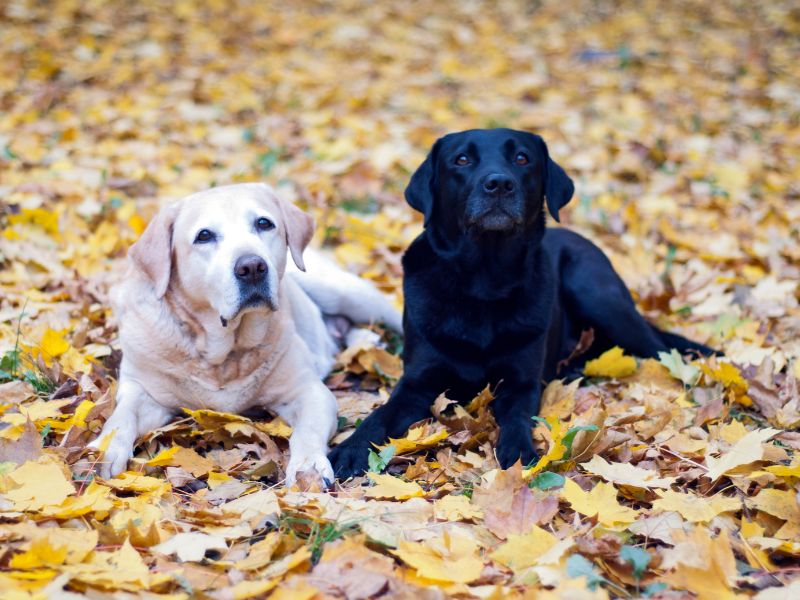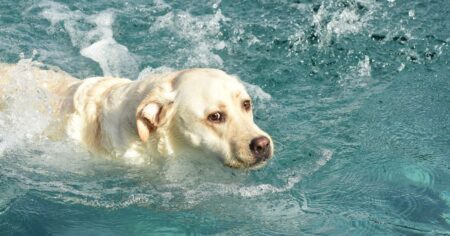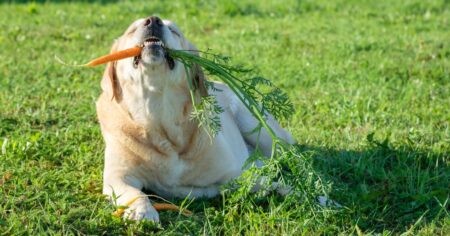The Labrador Retriever, known for its friendly and good-tempered nature, is a popular breed among dog owners worldwide. These medium-sized, athletic dogs originally served as retrieving gun dogs in hunting scenarios. Being robust and versatile, Labradors are well-equipped to handle various weather conditions and environments, making them excellent companions for both waterfowl and upland game hunting ventures.
Known for their soft mouths, excellent noses, and a keen love for water, Labrador Retrievers exhibit unique traits related to their purpose and origins. The Labrador breed standard has been carefully set by national clubs, accounting for this breed’s specific physical appearance characteristics and temperament. While standards may vary slightly between countries, it remains clear that these elements are essential in preserving the traits that make Labradors so loved and distinct. Though some Labs may not meet every detail of the breed standard, the core features and behavior remain constant across different lines.
When considering the breed standard, it’s not just the appearance that holds significance, but also the beloved temperament of Labrador Retrievers. These good-tempered, highly adaptable dogs have earned their place in countless homes around the world as devoted, loyal companions.
The Labrador Breed Standard
The Labrador Retriever is known for its friendly and outgoing character, with a true love of water and excellent retrieving skills. The breed standard is designed to evaluate Labradors based on their appearance, temperament, and physical capabilities, ensuring the breed remains true to its original purpose as a working dog.
FAQ Quick Links!
What is the ideal height of a Labrador?
For male Labradors, the ideal height at the withers is 22.5 to 24.5 inches, while for a female, it is 21.5 to 23.5 inches. A variance greater than 0.5 inches above or below these heights is generally not desired.
What is the ideal weight for a Labrador in working condition?
Male Labradors in working condition ideally weigh between 65 to 80 pounds, while females typically weigh between 55 to 70 pounds.
What key characteristics define a Labrador?
A Labrador Retriever is expected to have a good temperament, be very agile, possess an excellent nose and soft mouth, display a keen love for water, and be an adaptable devoted companion.
It is important to maintain these breed standards to ensure the soundness and functionality of the Labrador Retriever as a working dog, while also preserving the friendly and affectionate demeanor that makes them such popular companions. By adhering to these guidelines, breeders and enthusiasts can help maintain the integrity of this beloved breed.
What Is A Breed Standard?
A breed standard is a set of guidelines that describes the ideal characteristics, temperament, and appearance of a specific dog breed. These standards are established by national clubs and help to ensure the breed maintains its distinct features and remains fit for its intended function. In a friendly and informative manner, let’s take a closer look at what breed standards encompass and why they are essential.
Firstly, a breed standard outlines the physical features of a dog, which may include aspects such as size, coat type, color, and overall body structure. These standards ensure that breeders understand and aim to produce dogs that closely resemble the ideal representation of the breed. Additionally, breed standards also take into account the unique temperament traits that define a breed, such as energy level, temperament, and behavior.
Having these standards in place not only helps preserve the characteristics that make each breed unique, but it also promotes responsible breeding practices. Breeders who adhere to the breed standards strive to produce healthy, well-balanced, and temperamentally sound dogs. This helps to ensure the breed remains true to its origins and fit for its intended purpose, whether that is in the field, as a family pet, or even as a service or therapy dog.
In summary, a breed standard serves as an essential guide for breeders and enthusiasts alike, promoting the preservation of each breed’s unique characteristics, maintaining the quality and health of future generations, and ensuring dogs are temperamentally suited to their intended roles.
Who Decides The Labrador Breed Standard?
The Labrador breed standard is determined by national clubs dedicated to the representation and preservation of the Labrador Retriever. These clubs work towards specifying the ideal appearance and characteristics of a pedigree Labrador, from head to tail. It is important to note that Labrador breed standards can vary slightly from country to country due to the different national clubs involved.
One of the most recognized clubs that sets the breed standard for Labradors is the American Kennel Club (AKC). The AKC’s official standard for the Labrador Retriever outlines aspects such as general appearance, size, proportion, and substance, as well as specific details about the head, coat, and gait. This helps to ensure that Labradors are bred with a consistent and functional appearance, suitable for their purpose as a retrieving gun dog.
In addition to the AKC, other regional clubs and organizations, like The Labrador Retriever Club Inc. in the United States, also contribute to the establishment of the breed standard. These clubs often collaborate with breed experts and enthusiasts to gain a better understanding of the Labrador Retriever’s history, purpose, and characteristics. This collaboration allows for the breed standard to be comprehensive and well-informed.
While national clubs play a significant role in deciding the Labrador breed standard, it is essential for breeders, judges, and owners to follow these guidelines when breeding, exhibiting, or selecting a Labrador Retriever. By adhering to the standard, individuals can ensure that the breed remains true to its original traits and maintains a consistent appearance and temperament over time.
What Is A Kennel Club?
The Kennel Club
The Kennel Club is a British organization founded in 1873, which aims to protect and promote the health and welfare of dogs. It sets the breed standards, organizes dog shows, and registers purebred dogs in the United Kingdom. The breed standard of a Labrador Retriever, according to The Kennel Club, describes the ideal characteristics, temperament, and appearance of the breed, ensuring it is fit for function and maintaining proper soundness.
The American Kennel Club
The American Kennel Club (AKC) is a United States-based organization founded in 1884, which oversees various dog-related activities such as setting breed standards, hosting dog events, and registering purebred dogs in the US. Similar to The Kennel Club, the AKC has a breed standard for the Labrador Retriever which describes the ideal dog, considering aspects like appearance, temperament, and physical ability. This breed standard serves as a benchmark against which dogs are judged at shows and other events.
The ANKC
The Australian National Kennel Council (ANKC) is the governing body for purebred dogs and dog sports in Australia. Established in 1958, the ANKC sets breed standards, administers pedigrees, and oversees various dog activities in the country. The ANKC’s breed standard for the Labrador Retriever defines the ideal appearance, characteristics, and temperament of the breed, and provides a framework against which dogs are judged during events and shows.
Who Runs The Kennel Clubs?
Kennel clubs are organizations dedicated to maintaining breed standards and promoting the best interests of dogs. They are generally run by committees or boards made up of enthusiasts, breeders, and other stakeholders. For example, the The Kennel Club is the oldest and most recognized kennel club in the United Kingdom, responsible for setting breed standards and governing dog shows, among other activities.
Across the pond, the American Kennel Club (AKC) is the primary authority on breed standards and dog-related activities in the United States. Similar to its British counterpart, the AKC is comprised of enthusiasts and experts, with a focus on promoting the well-being of purebred dogs.
The United Kennel Club (UKC) is another organization, which, despite sharing a similar name, is in fact based in the United States. It is a registry for purebred dogs and also oversees various competitions and events related to the canine world.
While each kennel club may have its specific guidelines and policies, many of their goals and objectives align, such as:
- Establishing and upholding breed standards
- Ensuring the health and well-being of dogs
- Promoting responsible dog ownership
- Encouraging events and activities that showcase the unique abilities of each breed
In summary, kennel clubs are overseen by dedicated individuals who work tirelessly to preserve and promote the standards, health, and welfare of all dog breeds, including the beloved Labrador Retriever. By collaborating with breeders, enthusiasts, and fellow dog lovers, these organizations play an essential role in the world of purebred dogs.
Setting The Labrador Retriever Breed Standard
The Labrador Retriever breed standard serves as a guideline carefully crafted to describe the ideal characteristics, temperament, and appearance of a Labrador Retriever. This breed standard is essential for maintaining the unique traits and qualities that make Labradors so well-loved around the world.
National clubs set the Labrador breed standard in each country, and while small variations may exist between nations, the core traits remain the same. Some of the key characteristics that define the ideal Labrador Retriever include:
- Good-tempered: Labrador Retrievers are known for their friendly and easygoing nature, making them excellent family pets and companions.
- Agile: Labradors should be physically fit and energetic, avoiding excessive weight or bulkiness that could limit their agility.
- Excellent nose and soft mouth: These qualities enable Labradors to excel as working dogs, particularly in hunting, tracking, and retrieving.
- Keen love of water: Labradors are famous for their affinity to water, making them natural swimmers and competent working dogs for waterfowl retrieval.
In addition to these characteristics, the breed standard often provides details regarding the ideal height, weight, and proportions of a Labrador Retriever. Though many Labradors may not meet every detail of the breed standard perfectly, the guidelines ensure that judges in dog shows and competitions fairly evaluate each dog based on a shared understanding of the ideal Labrador Retriever.
While physical appearance is a significant aspect of the breed standard, a Labrador’s temperament should never be overlooked. The breed is renowned for its adaptability and devotion, making it perfect as a companion, service animal, or therapy dog.
In conclusion, the Labrador Retriever breed standard functions as a valuable reference to preserve the unique qualities and traits that make this breed so beloved. By adhering to these guidelines, breeders and enthusiasts can help maintain the breed’s integrity and foster its continued popularity across the globe.
What Are Labrador Breed Standards For?
Labrador Breed Standards serve as a guideline for breeders, dog show judges, and enthusiasts, helping them identify the physical and behavioral characteristics of a well-bred Labrador Retriever. These standards are not only about the dog’s appearance but also encompass temperament and physical abilities, focusing on creating an ideal Labrador that is fit for its historical work as a retriever gun dog.
The standards are set by national clubs, such as the American Kennel Club or The Kennel Club in the UK. While there might be minor differences between countries, the overall breed standards remain consistent. They play a crucial role in maintaining the breed’s uniformity and eliminating any undesirable traits that might hinder the dog’s abilities or affect its health.
A Labrador Retriever meeting the breed standard is described as being strongly built, short-coupled, and very active. The dog should have a broad skull, a deep chest and ribs, and a strong loin and hindquarters. In addition, Labradors are known for their good temperament, agility, soft mouths, keen love for water, and being adaptable, devoted companions.
These standards have a practical purpose, ensuring that Labradors retain the physical traits necessary for their original working role as retrievers. Moreover, breed standards help raise healthy Labradors by encouraging responsible breeding practices and discouraging breeding dogs with genetic issues or exaggerated features that might compromise the dog’s quality of life.
In summary, Labrador Breed Standards exist to maintain the consistency and quality of the breed, while also ensuring the health, temperament, and abilities of these popular and beloved dogs.
What Does The Ideal Labrador Look Like?
The ideal Labrador Retriever is a medium-sized, strongly built, and athletic dog with a well-balanced conformation. They are known for their soft mouth, excellent noses, and keen love of water. Both male and female Labradors have distinct size and weight ranges, where males should be 22-1/2 to 24-1/2 inches tall at the withers and weigh between 65 and 80 pounds, while females should be 21-1/2 to 23-1/2 inches tall and weigh between 55 and 70 pounds.
The head of a Labrador is one of its most recognizable features. The ideal Lab should have a wide, but balanced skull with the top being parallel to the muzzle, and both parts being approximately the same length. They should also have medium-sized, kind, and expressive eyes, with hinged ears that fall just above the eyes.
Labradors are well-known for their thick and waterproof double-coats. The topcoat is short, dense, and straight, while the undercoat is soft and weather-resistant, providing insulation and protection. The coat color can be black, yellow, or chocolate, with no preference given to any particular shade. Small white spots on the chest are quite common and acceptable. However, large patches of white or any other body markings are considered deviations from the breed standard.
Labradors should have a deep and wide chest with well-sprung ribs, providing ample space for the heart and lungs. The back should be strong and level from the withers to the hip joint, which contributes to their agile movements. The tail, known as the “otter tail,” is a distinctive feature of the breed – it should be thick at the base, gradually tapering towards the tip, and covered with short, dense hair.
A vital component of the ideal Labrador is their temperament. Described as good-tempered, adaptable, and devoted companions, Labs are prized for their friendly, outgoing, and non-aggressive nature. Their eagerness to please and inherent intelligence make them excellent as family pets, service animals, and competitive sports partners.
In conclusion, the ideal Labrador Retriever should have a well-balanced and athletic build with a friendly, adaptable temperament. Although breed standards may have minor variations between countries, these characteristics form the foundation that defines the Labrador Retriever we know and love today.
Labrador Breed Standard USA
Height
The ideal height for a Labrador Retriever in the USA is between 22.5 and 24.5 inches for males, and between 21.5 and 23.5 inches for females. The height is measured from the withers, which is the top of the dog’s shoulder blades. It is important to note that exceeding or falling short of the ideal height range may result in a less than perfect evaluation.
Weight In Working Condition
Labrador Retrievers should have a weight proportionate to their height and build when they are in a working condition. Males typically weigh between 65 and 80 pounds, while females weigh between 55 and 70 pounds. These weights are not set in stone but should provide a guideline for a healthy and fit Labrador Retriever. Ideally, the dog should appear well-muscled and balanced without being overweight or underweight.
Color
Labradors come in three accepted colors: black, yellow, and chocolate. Black Labs possess a bluish-black coat color, while yellow Labs have a range from light cream to golden, and chocolate Labs can vary from a light chocolate shade to a darker, rich chocolate color. No other coat colors are accepted in the breed standard, and dogs with unrecognized colors like silver are regarded as not conforming to the breed standard.
It’s crucial to remember that the Labrador Retriever’s breed standard is a guideline for evaluating the dog’s overall appearance and structure. Small deviations from the standard are common and do not necessarily mean the dog is not a good representative of its breed. Always prioritize the dog’s health, temperament, and abilities while keeping the breed standard in mind.
Get Pippa’s Training Tips!
Labrador enthusiasts can greatly benefit from the expertise of Pippa Mattinson, a renowned dog trainer with over forty years of experience working with dogs. Pippa has a wealth of knowledge to share with those looking to train their Labradors effectively and efficiently.
In Pippa’s training tips, she covers a range of pertinent topics related to Labrador training. These include:
- Basic Obedience: Ensuring your Labrador understands essential commands and follows them.
- Improving Dog Behavior: Providing guidance on how to address common behavioral issues and develop a well-mannered Labrador.
- Training Skills Development: Helping you refine your own training abilities and better understand your dog’s learning process.
- Fun Dog Training Tricks: Teaching your Labrador entertaining tricks that can delight and impress family and friends.
Labrador owners have access to these valuable tips through Pippa’s free dog training lessons. By signing up for her email-based training tips, individuals will have the opportunity to receive guidance on training their Labradors in a friendly, informative manner.
To ensure your Labrador’s training success, remember to always be patient, consistent, and positive. By incorporating Pippa’s training tips into your daily routine, you’ll be well on your way to having a happy, well-trained Labrador companion.
The Labrador Breed Standard UK
Height
The Labrador Breed Standard in the UK, as defined by The Kennel Club, outlines the ideal characteristics, appearance, and temperament of a Labrador Retriever. One of the key aspects in these standards is the height of the dog.
In general, male Labradors should have a height of around 56 – 57 cm (22 – 22.5 inches) at the withers. Meanwhile, female Labradors should have a height of around 54 – 56 cm (21.5 – 22 inches) at the withers. It is important to note that these measurements are provided as a guideline and slight variations are acceptable.
These height guidelines help breeders maintain the overall quality of the Labrador Retriever breed, ensuring that the breed remains consistent worldwide and can continue to excel as a working dog and family companion.
In summary, the UK Labrador Breed Standard for height aims to maintain consistency within the breed and enhance their natural abilities as both a working dog and loving companion.
Labrador Breed Standard Australia
The Labrador Retriever Breed Standard in Australia is the foundation that defines the ideal characteristics, temperament, and appearance of the breed. These guidelines are essential for ensuring the breed remains sound, fit, and maintains its purpose as a valued working dog and loving companion.
The Australian National Kennel Council (ANKC) oversees the breed standards and has adopted the standard from the Kennel Club London, with updates last made in 2018. The standard is recognized with the FCI Standard No. 122, highlighting the Labrador Retriever’s strong origins and importance within the Gundog group.
In terms of appearance, the Australian Labrador Breed Standard outlines the importance of balance and proportion within the breed. A Labrador should exhibit a strongly built, short-coupled body, with powerful limbs and a deep chest. The standard emphasizes the breed’s functionality, with broad and muscular hindquarters showcasing its strong working background.
The Labrador’s head is a distinctive feature, with the breed standard describing it as clean-cut, displaying strong but kindly expression. This friendly demeanor, a result of the Labrador’s good-natured temperament, solidifies the breed’s reputation for being loving and trustworthy.
Consistency across the breed also extends to coat colors, which can only be black, yellow, or chocolate. Each of the colors should be solid and free from markings, demonstrating a well-bred lineage.
The desirable features are not only for the admiration of the breed’s appearance but also highlight the requirements for the Labrador to perform its original purpose as a retriever. A strong neck, powerful shoulders, and a strong hindquarters allow for effortless swimming and carrying heavy objects.
Last but not least, the breed standard upholds the ideal Labrador temperament. Australian Labradors should be intelligent, good-natured, and friendly, with an outgoing and eagerness to please. These traits collectively contribute to their suitability as a working dog, family pet, and loving companion.
The Labrador Breed Standard in Australia serves to maintain the perfect blend of appearance, temperament, and functionality of the breed. Prospective owners and breeders can rely on these guidelines as a blueprint to ensure the Labrador’s continued integrity and purpose in Australia.
Are Labrador Breed Standards A Good Thing?
Labrador Retriever breed standards serve as guidelines to describe the ideal appearance, temperament, and characteristics of this popular dog breed, set by national clubs like The Kennel Club and American Kennel Club. These standards ensure that Labs are fit for function and maintain their distinctive traits, benefiting both breeders and pet owners alike.
Breed standards help preserve the unique qualities of Labrador Retrievers, such as their friendly nature, keen love of water, and adaptability as loyal companions. By adhering to these guidelines, breeders can ensure they produce dogs with the desired appearance and temperament, keeping the breed true to its origins.
Additionally, Labrador breed standards are essential in dog shows, where Labs are judged against these ideal characteristics to determine their quality and conformity within the breed. By having a defined standard, judges can assess and compare dogs objectively, ensuring fairness and consistency in these competitions.
However, it’s essential to recognize that not every Labrador will meet every detail of the breed standard perfectly, and that’s perfectly fine. Many wonderful and loving Labs might not fit the ideal appearance but still make incredible family pets and companions. In such cases, the emphasis should be on the dog’s health, temperament, and overall happiness rather than achieving the perfect breed standard.
In conclusion, Labrador breed standards play a vital role in maintaining the breed’s unique traits and preserving their rich history. They benefit breeders, pet owners, and the dogs themselves by providing clear guidelines for appearance and temperament. However, it’s important not to lose sight of the individuality and well-being of each dog, even if they don’t precisely conform to the breed standard.
My Labrador Doesn’t Meet The Breed Standard!
Not every Labrador will perfectly meet the breed standard, and that’s completely normal. The Labrador breed standard is an ideal set by national clubs to guide breeders and judges in dog shows. It is essential to remember that the primary purpose of a breed standard is to maintain the breed’s distinctive features, not to exclude other dogs or create a breed “ideal.”
First and foremost, it is crucial to understand that breed standards do not always determine a dog’s value or the owner’s affinity for their pet. Labrador breed standards generally focus on physical attributes, such as size, coat color, and head shape. However, the Labrador temperament, such as being good-tempered, agile, and adaptable, is just as important and defines the breed’s characteristics.
If your Labrador doesn’t meet every detail of the breed standard, it doesn’t indicate anything wrong with the dog. In fact, many Labradors might not perfectly adhere to every standard but are still considered healthy, happy, and loving pets. It is essential to focus on the dog’s overall well-being and care, ensuring that it is provided with proper nutrition, exercise, and veterinary care.
Remember that the breed standard was established for the purpose of maintaining consistency and quality within the breed population, not to exclude or devalue certain dogs. If your Labrador does not meet the official breed standard, it should not be an issue as a beloved family pet. However, if you wish to enter your dog in conformation shows, you may need to consider the breed standard more closely.
In the end, a healthy and well-cared-for Labrador will bring joy and companionship to its owner, regardless of how closely they adhere to the breed standard. Embrace your Labrador’s unique qualities and cherish the bond you share with them.
Why Some Labradors Don’t Meet The Breed Standard
Labrador Retrievers are highly popular due to their gentle nature, intelligence, and adaptability. However, it’s important to understand that not all Labradors meet the breed standard. There are a few reasons for this, which we will discuss in this friendly and concise section.
Firstly, the Labrador breed standards are determined by national kennel clubs, and as a result, the specific requirements might differ slightly from country to country. This means that a Labrador considered ideal in one country might fall short in another country’s breed standard.
Additionally, Labrador breeders might prioritize different traits based on their preferences or the intended purpose of the dog. For example, a breeder focusing on hunting dogs might value athleticism and a strong retrieving instinct over a perfect coat color, while another breeder aiming to produce family pets might emphasize temperament and trainability.
Genetics also plays a significant role in determining a Labrador’s physical characteristics. With genes carrying various traits, it’s not surprising that some offspring may inherit a combination of features that don’t strictly adhere to the breed standard. In some cases, these dogs might still be registered as pedigree Labradors, but they won’t be considered ideal specimens for participating in conformation shows.
Lastly, environmental factors, such as diet, exercise, and grooming, can also influence a Labrador’s appearance and even temperament. A well-cared-for dog has a better chance of meeting the breed standard than a neglected one.
In conclusion, not all Labradors meet the breed standard due to variations in kennel club requirements, breeder preferences, genetics, and environmental factors. While these dogs might not be the ideal representation of the breed, it is essential to remember that many Labradors still make wonderful companions even if they don’t perfectly fit the breed standard.
Purchasing A Puppy, And The Breed Standard
When considering the purchase of a Labrador Retriever puppy, it’s essential to keep the breed standard in mind. The breed standard specifies the ideal appearance and temperament of a pedigree Labrador Retriever, which is established by various national clubs and may slightly vary between countries.
Before bringing a Labrador puppy into your home, research the breed standards and reputable breeders. A responsible breeder will strive to breed dogs that meet the standards, ensuring a healthy and well-tempered companion. Familiarizing yourself with these standards will help identify a quality puppy from a responsible breeder.
Size, Proportion, and Substance are key aspects of the Labrador breed standard. The ideal height at the withers for a male dog is 22½ to 24½ inches, while for a female, it’s 21½ to 23½ inches. The Labrador should display substance without being clunky or heavy, and display style and quality without being overly refined.
One striking feature of Labrador Retrievers is their coat, which should be dense, short, and weather-resistant, as they were bred to work in various environments. The coat colors typically found in this breed are black, yellow, and chocolate.
The temperament of a Labrador is another essential aspect of the breed standard. Labrador Retrievers should be friendly, outgoing, and eager to please. They are known for their kind nature, intelligence, and excellent trainability, making them excellent companions and working dogs.
When purchasing a puppy, it is important to observe its temperament and physical characteristics to ensure that it aligns with the breed standard. Also, ask the breeder about the pedigree, health history, and any genetic testing performed on the parents. Taking the time to understand the breed standard and choosing a responsible breeder will increase your chances of bringing home a healthy, happy Labrador puppy that fits the ideal characteristics of this popular breed.
Do Pet Labradors Need To Meet The Breed Standard?
Labradors are popular pets, known for their friendly and adaptable nature. While the breed standard is important for breeders and those participating in dog shows, it’s not as crucial for pet Labradors.
Pet Labradors don’t need to meet every detail of the breed standard to be great companions. The breed standard is mainly focused on physical appearance and some specific characteristics for competition. For pet owners, it’s more important to focus on the health and temperament of their Labrador.
Health should be a top priority for selecting a pet Labrador. Issues such as hip and elbow dysplasia, progressive retinal atrophy, and obesity are more relevant to a pet Labrador’s overall well-being than conforming to the breed standard. Ensuring proper exercise, diet, and regular veterinary check-ups will contribute to a happy and healthy pet.
Temperament also plays a significant role in the Labrador’s suitability as a pet. The breed standard points out the “good-tempered” nature of Labradors as one of their characteristics. This quality makes them excellent family pets and service dogs. A friendly and sociable personality is essential for enjoying life with a Labrador, regardless of whether they meet the breed standard in terms of appearance.
Finally, remember that each Labrador is unique and may not look exactly like the breed standard. Embracing your pet’s individuality and focusing on their health and temperament will provide a better experience for both you and your Labrador. The bond between a pet and its owner matters far more than fitting into an exacting breed standard.
Summary
The Labrador breed standard is a set of guidelines that outline the ideal appearance and characteristics of a pedigree Labrador Retriever. These standards are established by national clubs and can vary slightly from country to country. However, they all serve as a general blueprint for what a Labrador should look like and how it should behave.
Labrador Retrievers are known for their strength, agility, and friendly nature. As per the breed standard, they should be strongly built, short-coupled, and very active. The skull should be broad while the chest and ribs should be deep and broad as well. Additionally, the loins and hindquarters must be robust and sturdy, reflecting the breed’s origins as a working dog.
The breed was initially developed for retrieving tasks in various weather conditions and environments. This versatility has allowed Labradors to adapt to different regions around the world and take on a range of roles beyond their traditional work in the shooting field. Their physical characteristics and temperament contribute to their widespread popularity as both working dogs and family pets.
In summary, the Labrador breed standard emphasizes a balance of form and function. These beloved dogs should possess a strong, well-built physique that enables them to stay active and perform in various conditions. Their friendly and adaptable temperament further solidifies their position as a true all-around breed, making them a popular choice for many purposes.
How Does Your Lab Compare?
When considering the Labrador breed standard, it’s essential to remember that each dog is unique and may not meet the exact specifications outlined by national clubs. However, knowing the breed standard can provide a helpful reference for understanding your Lab’s characteristics and appearance.
According to the American Kennel Club (AKC) breed standard, a purebred Labrador Retriever should weigh between 55 and 80 pounds and grow to a height of 21.5 to 24.5 inches tall. There are three recognized coat colors for Labradors: yellow, black, and chocolate. The yellow coat color is accepted in various shades.
In terms of personality, the Labrador is known for its good temperament, agility, and adaptability. These dogs possess an excellent sense of smell, a soft mouth, and a great love of water. They are also adaptable and make devoted companions.
To assess how well your Labrador compares to these breed standards, consider the following aspects:
- Weight and Height: Measure your Labrador’s height and weight, and compare them to the standard ranges specified by the AKC.
- Coat Color: Observe your Lab’s coat color and determine if it falls within the accepted hues of yellow, black, or chocolate.
- Temperament: Evaluate your Labrador’s temperament by noting their behavior and interactions with other dogs and people.
- Physical Attributes: Examine your Lab’s physical attributes such as their ears, eyes, tail, and overall body shape, which should be well-proportioned and balanced.
Keep in mind that many Labradors may not meet every detail of the breed standard perfectly, and that’s okay! It is more important to focus on your dog’s overall health and happiness. By understanding the breed standards, you can better appreciate your Lab’s unique characteristics and ensure they are well cared for in every aspect of their life.
Readers Also Liked
Labrador Retrievers have captured the hearts of many dog owners around the world. As a friendly and lovable breed, it’s no surprise that many enthusiasts are interested in learning more about these dogs. Below are a few sections that Labrador owners and aficionados have found enjoyable, informative, and engaging.
One topic that consistently grabs attention is the Labrador breed standard. This specifies the ideal appearance and temperament of a pedigree Labrador Retriever. The breed standard is set by national clubs, which means it can vary slightly from country to country. Nevertheless, it serves as a blueprint for breeders to preserve the quality and future of the breed.
Another area of interest lies in the origins of the Canadian Labrador. Although not an officially recognized strain like the American or English Labrador, all modern Labs can trace their ancestry back to dogs that lived and worked in Canada. Learning about the Canadian Labrador adds depth to our understanding of the breed’s history and development.
Additionally, the Labrador temperament has been a topic worth exploring. Labradors are known for their friendly and outgoing nature, making them a popular choice for families and service roles. The breed’s working roles and selective breeding have contributed to their loveable personalities, but proper socialization and training are crucial for ensuring a well-rounded and balanced temperament.
References And Further Resources
For those interested in learning more about the Labrador breed standard, there are several reputable sources that provide a wealth of information. One great starting point is the American Kennel Club (AKC), which provides detailed information on the general appearance, temperament, and required breed standards for Labradors.
Another valuable resource is the Labrador Retriever Illustrated Standard provided by the Puget Sound Labrador Retriever Association. This document offers a visual guide to key characteristics of the breed, which can be useful to both potential owners and breed enthusiasts alike.
For those seeking general information about Labradors, Labrador Training HQ is a comprehensive website covering everything from training techniques to breed-specific health concerns. Articles such as “Labrador Breed Standard – What Makes a Lab a Lab?” dive into the breed’s history and defining traits.
Finally, the United Kennel Club (UKC) also provides a detailed overview of the Labrador Retriever breed standard. The UKC’s documentation includes information on various aspects of the breed, such as general appearance, size, head proportions, and coat types. This source is particularly valuable for those interested in learning about the similarities and differences between the AKC and UKC breed standards.
In summary, exploring these resources will provide a solid understanding of the Labrador breed standard. They offer a friendly and accessible way to learn more about this popular and versatile breed. Remember, it is essential to research and learn from reputable sources to ensure accurate and trustworthy information regarding the Labrador Retriever.


